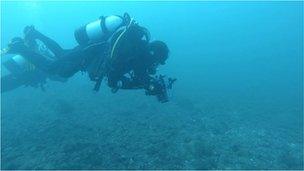Westermost Rough study into wind turbine marine life damage
- Published

Divers are assessing habitats at Westermost Rough in the North Sea
The damaged caused to marine life by offshore wind turbine developments is being studied by scientists off the East Yorkshire coast.
The habitat at Westermost Rough and marine life stocks are being surveyed as Dong Energy prepares to build 35 turbines in the area in 2014.
The same research will take place once the development is complete.
Scientists at the University of Hull and the Holderness Fishing Industry Group are working on the project.
They hope their findings will inform and influence developers as to how they can build wind turbines in an environmentally-friendly way.
Dong Energy has given its backing to the research.
Dr Ralph Bublitz, a marine scientists at the university, said: "[The development] is going to change and impact the habitat and the environment down there on the sea bed and the main question is how long is it going to take to recover."
Jamie Robertson, from the fishing group, said the Dong Energy scheme would disturb a prime lobster fishery that is key to Bridlington's wealth.
He said: "The fishery is worth somewhere in the region of seven to nine million pounds a year just in terms of first sale landing so if we can understand the effects of other things that are being done in the environment that supports that industry then we can better prepare for it."
Dong Energy was granted planning consent in January for 35 turbines located east of Hull in the North Sea, five miles (8km) off the coast.
The company said it would supply enough energy to power 210,000 homes.
Another offshore wind farm containing 73 turbines, the Humber Gateway, is also due to be built close to Westermost Rough.
- Published26 August 2013
- Published15 August 2013
- Published30 January 2013
- Published9 February 2011